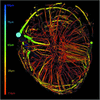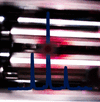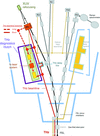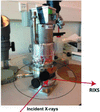issue contents
May 2019 issue

Cover illustration: Determining the nature and reactivity of intermediates formed under reaction conditions is paramount to elucidate the mechanism of catalytic reactions. In situ and/or operando characterization experiments, using several techniques synchronously becomes mandatory. Each technique can provide information on different aspects or at different scales on the catalytic material or the adsorbates complementing each other. See Meira, Monte, Fernandez-Garcia, Meunier, Mathon, Pascarelli and Agostini, pages 801-810.
facility information
topical reviews
This review focuses on recent progress in synchrotron radiation methodology and its application in probing neurovascular networks, especially the pathological changes associated with vascular abnormalities in various model systems.
research papers
The feasibility of on-line monitoring of the spatial properties (including intensity distribution, coherence and wavefront profile) of a hard XFEL beam using a grating splitter is presented.
Open  access
access
 access
accessAn instrument for photon-in photon-out spectroscopy at XFELs in the energy range between soft and hard X-rays is presented.
High peak power and high brightness hard X-ray generation achievable in the double-bunch LCLS-II operation is reported.
Open  access
access
 access
accessDevelopment and evaluation of a spatial and temporal determination diagnostic for X-ray free-electron lasers.
Open  access
access
 access
accessThe development of novel single-particle imaging injection instrumentation at the European XFEL beamline SPB/SFX is presented.
Open  access
access
 access
accessAn introduction to the early operational capabilities of the Single Particles, Clusters and Biomolecules and Serial Femtosecond Crystallography (SPB/SFX) scientific instrument at the European X-ray Free Electron Laser facility is presented.
A novel technique is proposed which uses angular dispersion to enhance the high-harmonic bunching of the electron beam for generating ultrashort and coherent extreme-ultraviolet and soft X-ray free-electron laser pulses in storage rings.
Open  access
access
 access
accessTechniques developed at LCLS to make optical laser pump–X-ray probe experiments both robust and easy to implement at ultrafast X-ray free-electron lasers are presented.
The beam transport system of the European XFEL SASE1 beamline is described together with experiences gained during the first user runs.
Open  access
access
 access
accessA range of THz diagnostic tools developed for THz/XUV pump–probe experiments at FLASH1, DESY, are presented.
Grating structures with 150 nm pitches were fabricated on free-standing CVD diamond membranes supported by a silicon frame. The efficiencies and structural homogeneity of the gratings were measured with synchrotron X-rays at different photon energies.
Full-field X-ray microscopy with a resolution of 100 nm, achieved by polymer compound 3D refractive nano-lenses, is demonstrated. This article also dicusses issues related to lens aberrations, astigmatism and radiation stability, and thus ways of improving the lens further are considered.
The structure, stress and optical properties of Cr/C multilayers with the same period (about 11.64 nm) and bi-layer number (20) but with different Cr thickness ratio (0.20–0.80) are discussed. An optimal Cr thickness ratio of 0.37 is defined in view of high reflectivity and low stress.
An iterative global optimization method is developed to enable piezoelectric deformable mirrors to effectively approach a target figure or realize phase compensation based on in situ or ex situ metrologies.
The large dispersion in undulators tuned at resonance in the THz range can be responsible for a change in the electron beam form factor in the case of the presence of energy chirp, leading to enhancement or suppression of superradiant THz emission.
Open  access
access
 access
accessUsing an asymmetric diffraction geometry, a silicon double-crystal monochromator can produce a higher photon flux than the standard symmetric geometry for low-emittance synchrotron radiation X-rays, while the outgoing beam from the monochromator maintains its narrow angular spread. These features are well suited to synchrotron diffraction and scattering.
A Fresnel-mirror-based optical system was constructed to determine the degree of spatial coherence at the soft X-ray beamline of SPring-8. The spatial coherence properties in the horizontal and vertical directions were measured with a transverse range of larger than 1 mm.
Open  access
access
 access
accessA statistical approach to correct X-ray response non-uniformity in microstrip detectors was developed and applied to a detector system, which enabled high-accuracy and high-resolution total scattering measurements in a wide range of scattering vector.
Open  access
access
 access
accessA detailed kinetic and mechanistic study of the hydration of CaSO4·0.5H2O to CaSO4·2H2O is reported. This is a one-step process with no crystalline intermediate phases, and the addition of increasing amounts of CaSO4·2H2O reduces the importance of nucleation in controlling the reaction rate.
Open  access
access
 access
accessThe design and development of a photoelectron spectromicroscope working in transmission mode are presented.
W/B4C multilayer structures are characterized using various experimental techniques. The influence of B4C layer thickness on the optical performance near the B K-edge is discussed.
Open  access
access
 access
accessA new cell is demonstrated that has been designed and tested to perform in situ X-ray absorption, diffuse reflectance IR Fourier transform and mass spectroscopies. It is possible to perform X-ray absorption spectroscopy measurements in transmission or fluorescence modes. The best configuration can be adjusted depending on the specific requirements of the experiment, and the cell is compatible with external devices like UV-light and Raman probes.
Open  access
access
 access
accessFrom 1s X-ray absorption and 1s3p resonant inelastic X-ray scattering, the valence, coordination and symmetry of cobalt ions were tracked in two cobalt-promoted molybdenum oxide precursors of the hydrodesulfurization catalyst system.
Time-resolved X-ray reflection phases of the nearly forbidden Si(222) reflection under laser excitation are investigated using multiple-wave diffraction at 7.82 keV. A relative phase change of around 4° of Si(222) in the first 100 ps of laser excitation and its gradual recovery over several nanoseconds are observed.
A method for fast three-dimensional reconstruction of multi-material objects based on propagation-based X-ray phase-contrast tomography with phase retrieval using the homogeneous form of the transport of intensity equation is presented.
Open  access
access
 access
accessA convolutional neural network has been designed to quickly and accurately upscale the sinograms of X-ray tomograms captured with a low number of projections, effectively increasing the number of projections. This is particularly useful for tomograms that are part of a time-series as, in order to capture fast-occurring temporal events, tomograms have to be collected quickly, requiring a low number of projections. The upscaling process is facilitated using a single tomogram with a high number of projections for training, which is usually captured at the end or the beginning of the time-series when capturing the tomogram quickly is no longer needed.
beamlines
The instrumentation and commissioning results of the reaction microscope endstation at FLASH2 are reported.
Open  access
access
 access
accessThe experimental lasers at the PAL-XFEL beamlines, from the source to the sample position, are described.
Open  access
access
 access
accessThe Bernina instrument at SwissFEL Aramis employs laser-pump and X-ray-probe techniques to selectively excite and probe the electronic, magnetic and structural dynamics in condensed matter systems on the femtosecond time scale and under extreme conditions.
Open  access
access
 access
accessArrival timing diagnostics between a soft X-ray free-electron laser and synchronized optical laser pulses were performed at SACLA BL1.
For three undulator technologies – in-vacuum, cryogenic and superconducting – the optimal parameter space for an X-ray free-electron laser is examined in the self-amplified spontaneous emission operation mode.
The new monochromator beamline at FLASH, the free-electron laser of Hamburg, is designed to work in the soft X-ray range, covering a spectral range from 1 to 20 nm and with a spectral resolution of approximately 2000. Wave-propagation simulations were performed to provide the design of this beamline further insights with respect to the optical quality required.
addenda and errata
Open  access
access
 access
accessThe list of authors in the paper by Juranić et al. (2018>) [J. Synchrotron Rad. 25, 1238–1248] is corrected.


 journal menu
journal menu

























































